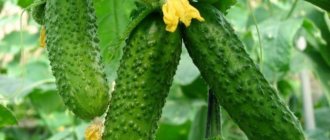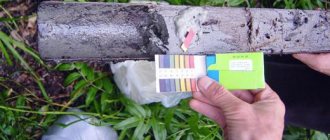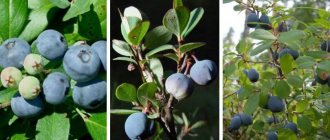Blueberries are not the most widespread cultivated plant in our country. Not every summer resident or garden owner decides to grow it along with raspberries, strawberries and cherries. One of the problems is pickiness about the soil. Blueberries simply will not grow on ordinary soil. It needs high humidity - only in this case will it successfully develop and bear fruit. It is not surprising that many summer residents who decide to experiment with this rare crop have a question about how to acidify the soil for blueberries. We will try to answer it in as much detail as possible.
Why acidify the soil?
Let's start with the fact that blueberries traditionally grow in acidic soils, usually swampy. Most other plants die here. That is why, in order to survive, blueberries had to change and adapt to unusual conditions.
If you dig up its root system, you will see that it is practically devoid of thin branches - they will simply rot in the swamp. But there is a white coating on the roots. This is not a disease, as it may seem to the uninitiated. This is a type of mushroom. Experts call this symbiosis mycorrhiza, combining the Greek words “miko + rhiza,” that is, “mushroom + root.” As a result of this proximity, the plant receives from the fungus the necessary microelements and moisture, which it absorbs from the soil. If the fungus dies due to unsuitable conditions, then the blueberries will not be able to grow or develop normally. And it needs an acidic environment to survive. Therefore, acidifying the soil for blueberries is the only way to get a harvest.
What soil does blueberry like?
Blueberries grow in many regions of the country, but attempts to grow the wild plant at home usually end in failure. But breeders did not give up attempts to “cultivate” this berry, and their work was crowned with success. As a result, garden blueberry was bred - a cultivated variety that grows well and bears fruit abundantly when grown under artificial conditions.
One of the specific features of garden blueberries is its demands on soil. In garden conditions, it cannot be planted in a place where any cultivated plants previously grew. The soil should be light, breathable, moderately moist, with good drainage. Blueberries will not grow in swampy areas. Another important feature of the soil for this berry is its acidic reaction of the order of 3.5-4.5 pH. High-moor peat has this pH level, and it is these soils (peaty-sandy loam) that are the best for planting blueberries. To improve its properties, rotten leaves, pine litter, spruce or pine bark, and ground cones are added to it.
Why blueberries need acidic soil
The need for acidic soil is associated with the structural features of the blueberry root system. Unlike ordinary plants, it does not have the finest root hairs, with the help of which nutrients are absorbed from the soil. Their role is played by microscopic soil fungi that form mycorrhiza with blueberry roots. Thanks to them, the plant absorbs water and nutrients. However, such a symbiosis can only exist in an acidic environment; other soil is not suitable for this.
How to make soil for blueberries with your own hands
You can give any soil the properties necessary for normal blueberry growth by adding various components. It will also be necessary to artificially increase the acidity of the soil. The optimal substrate for growing blueberries is a mix of sand, high peat (at least 50% of the total volume), fallen pine needles and sawdust. It is very good to add a layer of topsoil from under coniferous trees to the nutrient soil, since it contains a large number of necessary fungi.
How to determine that the soil needs to be acidified
The easiest way to determine whether the soil under blueberries needs acidification is by the color of its leaves. If the acidity level is insufficient, they turn red. However, this method cannot be used in the fall, because at this time the plant begins to prepare for winter and the red color of the leaves is a natural reaction to cold weather.
How to determine soil acidity for blueberries
You can determine soil acidity in other ways. Here are some of them.
- pH meter. A specialized electronic device designed to accurately determine soil acidity. It is a probe on an insulated wire that is stuck into the soil in the desired area. The device readings are displayed on an indicator with a dial scale or digital values.
- Litmus. Sets of litmus test indicators can often be found in gardening stores. To determine acidity, a soil sample is poured with distilled water and stirred well. After the soil particles settle, a litmus test is taken. The acidity level is determined by the color of the indicator and special tables. Green color indicates an alkaline reaction, but if the acidity level is high, the sample turns red.
Optimal indicator for blueberries
Most cultivated plants grown in vegetable gardens prefer slightly acidic or neutral soil. If you give specific numbers, then the optimal indicator is considered to be a pH in the range of 5.5-7.5 units. Therefore, you need to think about soil acidification only if the indicator has increased above this parameter.
However, blueberries differ greatly in this requirement from most plants. It grows best if the soil has an acidity of about 3.5-4.5 units. When acidity increases to 5.5 (the minimum limit for many garden plants) and higher, blueberries begin to hurt and even die. Of course, there is no question of a rich harvest.
How to make soil acidic for hydrangeas
Hydrangeas are able to change the color of their petals, depending on the acidity level of the soil. True, this does not apply to all types of beautiful shrubs. Only a large-leaved or garden variety can offer such an opportunity. To make your dream come true, you can only plant shrubs with blue or pink flowers. White will never change the color of the petals.
The decisive factors for color changes are not only the acidity of the soil. Hydrangeas react to aluminum and phosphorus. One bush can produce red or pink flowers at a pH above 6.5, blue flowers at a pH below 5.5. At a pH of 5.5 to 6.5, the petals take on a purple hue. The blue color can be obtained only after adding aluminum sulfate or other fertilizers containing salts of this metal to the soil.
The necessary substances must be added in early spring, before the beginning of the growing season. Later changes will not affect the color of the inflorescences.
What plants need acidic soil?
However, blueberries are not the only ones that need acidic soil. Many other types of plants can also grow and develop normally only in soil with a low pH level. Berry crops include lingonberries, blueberries and cranberries. Quite a few shrub plants also need acidic soil - wild rosemary, rhododendron, heather, azaleas. Speaking about perennials, it is worth noting fern, dientra, gravilate and primrose.
If you plan to grow any of these plants on your plot, it would be a good idea to remember the need to regularly acidify the soil.
Features of caring for blueberries
The berry does not require special feeding. At the same time, it needs proper nutrition much more than the usual blueberries or strawberries. In the first year after planting, it is enough to use mineral fertilizers, applying them in early spring. At this stage, you can limit yourself to carrying out fortified mulching - add a mixture of pine sawdust and spruce needles, pine bark and straw to the ground. Starting from the second year of life, we begin basic feeding. Let's look at the main types of fertilizers that are best absorbed by blueberries:
- nitrogen fertilizers (ammonium sulfate, ammonium nitrate, urea). Necessary for the full process of growth and formation of fruits. On average, 50-90 g per bush is used, taking into account the fact that fertilizing is carried out in several stages: the first - in the beginning of spring (beginning of sap flow), the second - in early May, the third - in early June;
- potash fertilizers (potassium salt, potassium sulfate, potassium sulfate). They increase the shrub's resistance to frost and drought and protect against garden pests. The average requirement of one bush per year is 30-50 g. It is applied in two stages: the first - in April (2/3 of the total dosage), the next - in early June (1/3);
- phosphorus fertilizers (double phosphate, superphosphate). This type of fertilizing increases productivity and makes the plant more resistant to external influences. The application regimen is similar to potassium supplements.
Signs of lack of acidity
If blueberries are planted in an area where the pH exceeds the optimal one, then the fungus living on its root system dies. This results in the plant not receiving enough nitrogen. Well, any experienced summer resident can easily determine this - the symptoms are known to everyone. As a result, the green leaves become increasingly lighter, turn yellow, and then die.
Not surprisingly, it is nitrogen that promotes the growth of green mass: stems and leaves. And without it, the plant will not be able to grow new leaves, which is why the process of photosynthesis stops and it dies. There is only one way to prevent this - to acidify the soil in time. We'll talk about this a little later.
Preparing blueberries for winter
Garden blueberry is a deciduous tall perennial shrub from the genus Berry (Vaccinium) of the Vereskovy family. It can withstand frosts down to -25 degrees, but it will still be necessary to prepare the bushes for wintering in regions with harsh climates.
Before the onset of cold weather, the branches of the bushes are straightened and bent to the ground . To do this, you can use metal rods driven into the ground. Next, the branches can be covered with mulch or covered with agrofibre.
Attention! It is not recommended to use greenhouse film to cover blueberries for the winter - the branches under it will rot.
With the first snow, you can generously sprinkle the bent branches with it, this will protect the bush from the first frosts. And in the spring, when frosts no longer threaten, the protective cover is removed and dead branches are inspected and pruned.
Disinfecting treatments
We must not forget that blueberries are also susceptible to infection by pathogens, like other crops. The main danger is parasitic mushrooms that infect berry plantings with various diseases:
- cancer (burn) of the stem (the parasitic fungus Godronia gradually rings the shoot and eats the entire bark) is the main enemy of blueberries, regardless of the varietal variety and climatic zone;
- drying of the stem (damage to the stems by the fungus Botryosphere); signs – convex spotting of stems;
- double leaf spot (gray spots with a bright burgundy border on the leaf blade);
- anthracnose (the fungus appears as small light brown spots on leaves, stems, berries); the fungus prevents the preservation of the crop; the reason is excess moisture and nutrition;
- late blight;
- root and stem rot.
Some diseases appear in early spring, as soon as the snow melts, at temperatures of 0-10C. The plant has not yet had time to enter the vegetative growth process, there is no resistance.
For preventive protective treatment of blueberries, systemic (cell penetrating) drugs are used, for example, Skor.
Contact fungicides (eliminate mycelium on the surface) and normalization of living conditions (moderate nutrition, watering, lighting) help against spotting
To prevent viral, fungal and bacterial infections of the trunk, flowers, leaves, and root systems, fungicides and antiseptics are used in spring and autumn:
- Bordeaux mixture;
- copper sulfate;
- inkstone.
Determination of earth acidity
However, experienced gardeners will try not to lead to a situation in which the plant will get sick and may even die. Therefore, before planting blueberries on their plot, they will try to collect more information about the soil prevailing there. Of course, it is advisable to have a special device for this, but it is quite expensive, which is why it is not suitable for private use.
Therefore, it is much easier to use litmus test: a disposable, but reliable, simple and very cheap tool. It's very easy to use.
It is necessary to dig several holes about 20-30 centimeters deep (as the blueberry roots grow). From each you need to take a little earth: about a few tablespoons. All that remains is to mix it, slightly moisten it (if it is completely dry) and press the litmus paper to the soil. Gradually the color of the paper will change. All that remains is to check it with the indicator, which usually comes with litmus tests.
Yellow or light green colors correspond to pH 3 to 5 - ideal for blueberries. If the color is orange or red, this is a frankly alarming sign, indicating that the earth is too acidic, you need to increase the pH.
If the color is from rich green to blue or even purple, then the pH is already too high - you need to reduce this indicator. Fortunately, there are several simple and reliable ways to cope with this task.
How to plant blueberries correctly
Seedlings of this plant are usually sold in containers
Therefore, it doesn’t matter when you plant blueberries - in spring, autumn or even summer - the planting instructions will be the same
First of all, walk around your site and choose the sunniest place on it, located on a slight hill, but at the same time protected from the cold north wind. Remember, shaded, poorly ventilated and low-lying areas with heavy soil are not suitable for blueberries.
If you want to harvest a good harvest of blueberries every year, plant not one, but several different varieties of blueberries.
Now that you have decided on the location, you can start preparing the planting holes. They are usually recommended to be made in the following sizes:
- 50x40 cm on light soil;
- 60-70×25-30 cm - on heavy soil (with a mandatory 5-10 cm drainage layer).
The most suitable soils for blueberries are peat, sandy and sandy loam soils. If the soil in your garden does not meet these parameters, fill the planting holes with a special soil mixture consisting of 5 parts of red high peat, 2 parts of pine sawdust and 1 part of sand.
Planting blueberry seedlings is not a difficult task, but it requires compliance with certain rules. The main one is: you can’t plant plants with tangled and bent roots! Therefore, shortly before planting, immerse the seedlings (directly in containers) in water for 10-15 minutes, and then carefully remove them from the containers and carefully knead the intertwined roots with your hands. If you don’t do this, but plant blueberry seedlings as they are, they will develop very poorly for the first few years, and then they will die completely.
Place blueberry seedlings in the hole so that after filling with substrate they are 5-6 cm deeper than they grew before. Form depressions for watering (holes) around the bushes and pour at least 5 liters of water into each of them. When the water is absorbed, mulch the tree trunk circles with sawdust or coniferous forest litter (layer thickness - 5-8 cm). This will prevent moisture from evaporating.
Miniature and low-growing varieties of blueberries (such as Big Blue, Nord Blue, etc.) are recommended to be planted at a distance of 80 cm, medium and vigorous varieties (Blue Berry, Double, Duke, Lateblue, Elizabeth, etc.) - at a distance of 1. 2-1.5 m.
Different ways to oxidize soil
In general, there are several ways to properly acidify the soil for blueberries. To do this, you can use special plants, organic fertilizers, acids, and mineral elements.
Each method has unique characteristics. Some act very quickly, but increase acidity for a relatively short period of time, which means that the procedure will have to be repeated quite often. Other methods, on the contrary, give effect only after a few months. But they turn out to be more stable and durable.
In addition, some methods are relatively harmless; you certainly will not cause irreparable damage to the soil, although the effectiveness is not very high. Thanks to other techniques, you can regulate acidity, quickly changing it in the desired direction. But in this case, you should be very careful - incorrect handling of reagents or a small mistake will inevitably lead to the fact that it will be very difficult to grow anything on the ruined soil. Therefore, we will talk about different ways to acidify the soil.
Ready-made fertilizer mixtures
Please note that in a specialized store you can find ready-made mixtures for fertilizing blueberries. Do not forget that every year the amount of substances used for nutrition must be doubled, until the plant reaches six years of age.
After this, the volumes no longer change.
As for mineral mixtures, their use is extremely important for the normal functioning of the bush. It is recommended to apply this type of fertilizing for the first time in the spring at the beginning of March (active swelling of the buds) in a 10-liter volume (when calculating, it is worth taking into account the age of the plant)
The next more abundant (20 l) replenishment is made after 5-7 weeks. Experienced gardeners emphasize that the best absorption of fertilizers is also influenced by what time of day you do it. So, it is best to start the process on a cloudy but not rainy day, in the morning or evening. To avoid mistakes, watch the step-by-step video instructions.
If you want beautiful bushes to grow in your garden, abundantly strewn with large dark blue berries, you need to approach the topic of care very responsibly! Be careful when choosing fertilizers, because blueberries can suffer from various fungi and diseases. In most cases, they are provoked by improper watering, which causes stagnation of moisture in the root part or poor soil quality. More serious cases, for which the only solution is often to remove the plant, are viral diseases such as thready branches, dwarfism, and red ring spot. If you notice that the leaves are turning yellow, oxidize the soil more. This is possible by adding a small amount of peat or nitrogen fertilizers. The appearance of a shrub can alert a gardener to a nutrient deficiency. So, if young shoots begin to die, you need to add more potassium; the leaves have turned reddish, which means they lack phosphorus.
Treat the planted shrub carefully and with care, fertilize it and water it properly, but it just can’t take root? The problem may be that you have chosen a variety that is not intended for our climatic conditions. Let's look at several varieties of blueberries grown in our region:
- Patriot - tall, up to 1.5 m tall, medium-sized sweet and sour berries, resistant to frost and common diseases.
- Elizabeth: tall, with very large and sweet berries, characterized by abundant harvest - 4-6 kg per year from one bush.
- Duke - tall, up to 2 m tall, late flowering, winter hardy.
- Northland - 1 m tall, with blue dense berries, yield - 5-8 kg per year per bush; valued in decorative floriculture.
- Chippewa - medium-sized, up to 1 m tall, with very sweet light blue berries, can withstand temperatures down to -30 degrees below zero.
- Blugold is medium-sized, with sweet and sour berries of medium size, winter-hardy.
Approach the process of planting, feeding and caring for the purchased shrub carefully, then you will have a unique berry filled with vitamins on your table all year round. The beneficial properties of blueberries are known all over the world. It saves your heart from diseases, improves vision and promotes digestion, and prevents cancer. In addition, it contains a large number of antidepressants, so by consuming healthy berries, you will always be cheerful, active and happy.
We use organics
One of the safest ways to increase soil acidity for subsequent blueberry cultivation is to use organic fertilizers. Yes, the process drags on for several weeks or even months. But such acidification lasts a very long time: at least a season or even two. Coping with the task is quite simple. As top dressing, you can use fresh horse or cow manure, sphagnum moss, compost obtained from tree leaves, high-moor peat or rotted sawdust, pine needles.
It is best to use organic matter to acidify light soils mixed with sand. They are usually characterized by good aeration and water permeability. Here, bacteria contained in the soil and organic matter will actively decompose, releasing the necessary microelements, enriching the soil and changing its composition. An additional advantage is maintaining soil looseness and increasing fertility. Most crops will grow just fine.
On heavy clay soils, this will give an even longer, but very weak effect: the lack of oxygen will lead to the fact that the process of decomposition of organic matter will proceed very slowly. Therefore, you can use it to increase acidity, but as an additional solution.
How can you mulch the soil under blueberries?
The best mulch for blueberries is one that imitates natural forest floor. This is a mixture of rotten leaves, dry and rotted pine needles, peat, finely chopped bark of coniferous and deciduous trees. This cushion well protects the surface roots of blueberries from damage and winter cold, and is also an additional source of nutrients into the soil. Mulch also acidifies the soil and acts as an insulating layer that prevents the soil from drying out in the root zone and blocks the growth of weeds.
To mulch the root zone, you can also use ordinary dry high-moor peat. You can add small sawdust, dry hay or straw to it. Some mulch components rot quite quickly, so the condition of the root zone must be monitored. The thickness of the mulch layer should be 5-10 cm.
We use mineral compounds
To quickly increase the acidity of the soil, especially if we are talking about areas with clay soil, you will have to use special mineral compounds. These include colloidal sulfur and ferrous sulfate.
How to acidify the soil for blueberries with colloidal sulfur? Quite simple. One kilogram of the substance is scattered over an area of about 10 square meters, after which the earth is dug up to a depth of about half a spade bayonet. At this ratio, the pH will decrease by approximately 2.5 units. If this is not enough, the dose can be increased. It is advisable to do this in the fall - the process takes about 8-12 months to start. In spring, acidity will rise to the minimum required level, and by the end of summer, when berries are formed, the indicator will reach the optimal value.
Ferrous sulfate is also quite easy to work with. Moreover, it gives a faster effect, although not as long-lasting. By adding 500 grams of powder per 10 square meters of land and digging up the area, you can reduce the pH by one, and it will take only one month. But such an operation will have to be performed at least once a year. Otherwise, the acidity of the environment will increase again. Although, of course, before oxidation you need to use an indicator and find out the current indicator. It is very important to know how often to acidify the soil for blueberries so that they grow well, but at the same time do not die due to excess acid.
Sulfur for blueberries - element No. 1
Blueberries are an elite berry. It requires a special approach. If only because it lives and grows well only on acidic soil. The fact is that there are no root hairs on its roots. And they develop only in close symbiosis with such a specific fungus as ericoid mycorrhiza.
“All heathers, and blueberries are one of them, have a unique root physiology,” explains
leading researcher at the industrial laboratory for the introduction and technology of non-traditional berry plants of the Central Botanical Garden of the National Academy of Sciences of Belarus, Candidate of Biological Sciences Tatyana Kurlovich
. — Unlike other crops, they are anchored, without root hairs. And blueberries feed only with the help of mycorrhiza - mycelium of symbiotic species of fungi. The plant gives it organic matter, and it, in turn, feeds the bush with minerals: nitrogen, phosphorus, potassium and other elements, and also supplies it with water. Blueberries and mycorrhizae do not exist separately. And this mycorrhiza lives only in an acidic environment with a certain pH level. Simply put, such an environment is not needed by the blueberry itself, but by the mycorrhiza that is located on its roots. Therefore, no organic matter (compost, humus) is added to blueberries; it is detrimental to them because it alkalizes the soil. After all, the plant stops receiving nutrition from the roots: mycorrhiza simply does not work under these conditions.
And then we begin to apply sulfur, as well as sulfur-containing fertilizers. But for blueberries, sulfur is also one of the main nutrients. If there is not enough of it, chlorotic spots appear on the leaves of the berry plant. And if sulfur deficiency is very acute, then in severe and extremely advanced cases the leaves become whitish-pink or even white. And the plants eventually die.
— Where to get sulfur and how best to apply it?
— As a rule, it is enough when using sulfate forms of fertilizers. Sulfates are salts of sulfuric acid. They are found in “Ammonium Sulfate”, “Potassium Sulfate”, “Magnesium Sulfate” and other fertilizers containing sulfuric acid residues. In the soil solution, sulfates break down into ions - positively and negatively charged particles. And in order for them to be absorbed most fully, the acidity of the soil is very important. The most optimal pH for blueberries, at which all nutrients will be available, is pH 4-5. If it is lower, then the bush will not be able to take potassium and calcium, and if it is higher, nitrogen, phosphorus, iron, magnesium, manganese and other microelements will be unavailable.
In areas with a pH above 5.5, blueberries practically do not grow and have light green leaves. The reason for this is insufficient absorption of nitrogen. And primarily due to the fact that mycorrhiza on blueberry roots does not work under such conditions. Therefore, it is so important to maintain optimal soil acidity.
To determine the degree to which plants are supplied with the necessary nutrients, leaf diagnostics can be carried out. Its main indicators are shown in Table 1.
— Why is sulfur deficiency in the soil dangerous?
“It increases the pH level, that is, it reduces acidity and impairs the activity of mycorrhiza. You can normalize the pH of the soil using acidified water. To prepare it, gardeners can use citric or oxalic acid (1 tsp per 3 liters of water), 9% acetic acid or apple cider vinegar (100 g per 10 liters of water). And also use special acidifiers (for example, “Pekatsid”), which are added to water for irrigation.
Acidification of the soil with sulfuric acid (or electrolyte) has the same effect, but it must be used very carefully. Sulfuric acid is a fairly aggressive compound; if used carelessly, you can burn not only the leaves and shoots of plants, but also your hands and other parts of the body.
If the pH of the water used to water the plants is above 5.5, then over time the acidity of the soil with which the planting hole is filled will also become above 5.5. To avoid this, you need to water the blueberry bushes with acidified water once a week (from April to September), but do this only if the soil pH initially does not meet the requirements.
If the soil pH is above 5.5, then when planting blueberries, add sulfur under disking or plowing. This method allows you to maintain the desired acidity level for several years. On average, regardless of the type of soil, if the pH is about 5 units, then it is recommended to apply 5 kg of sulfur per 1 sq.m., or 50 g per 1 sq. m. m. If the pH is 6, then we increase the norm to 10 kg per 1 hundred square meters, or 100 g per 1 sq. m. m.
The dose of sulfur application also depends significantly on the mechanical composition of the soil. Soils with a high content of organic matter and clay soils have an increased cation exchange capacity and, accordingly, high buffering capacity. In such areas, sulfur is consumed several times more than in light sandstones. And it is possible that in order to reduce the acidity to the desired level, it will have to be added several times. The lighter the soil, the less sulfur is needed. And light soils acidify faster. In general, the rate of sulfur application depends on the initial acidity level and the type of soil on the site (Table 2).
Usually sulfur is applied in the spring. In air, sulfur reacts with oxygen and oxidizes to sulfuric anhydrite. It, in turn, reacts with water in the soil and forms sulfurous acid, which acidifies the soil solution.
Sulfur decomposes very slowly in the soil. Therefore, after application, it works for several years, slowly acidifying the soil and feeding the blueberries.
- But sulfur is also an excellent fungicide.
— Yes, it perfectly suppresses pathogenic microorganisms, acting as a protector of plants from diseases. The active ingredient in many fungicides is sulfur. These drugs are actively used on blueberries against anthracnose and gray mold.
— Can green manure help somehow?
— By themselves, they do not reduce the acidity of the soil. They improve its physicochemical and mechanical properties, as well as the conditions for the growth and nutrition of blueberries. It is green manure crops that saturate the soil with organic matter, allowing the roots to go deep into the soil and better accumulate moisture, thereby creating a favorable water-air regime in the root habitat zone. Gradually decomposing, they supply blueberries with the mineral nutrition they need.
The best green manures for blueberries are marigolds and oats, which perfectly suppress the development of soil nematodes. Rye grass and rye are good green manures, but their use increases the likelihood of the proliferation of these dangerous pests. Other green manure crops produce an order of magnitude less organic matter.
If you wish, you can sow an acre or hectare with marigolds, but it’s still easier with oats. It is sown 2-3 times per season, adding 1 square meter each time. m up to 10 kg of “Ammonium Sulfate”. Fertilizers can be either scattered before sowing or applied immediately with the seeds. When the oats reach milky or milky-waxy ripeness, they are plowed. After 2-3 years of such sowing, the soil on the site becomes ideal for growing blueberries.
REFERENCE
What's missing from blueberries?
♦ Nitrogen - shoot growth is slowed down and leaves turn yellow. With a severe deficiency, the entire bush turns yellow, and reddish shades begin to appear on the leaves.
♦ Phosphorus - blueberry leaves turn purple and press against the stem.
♦ Calcium - a noticeable deformation of the leaves, on the edges of which yellowness appears.
♦ Potassium - the tips of the leaves begin to die, and the tops of young shoots turn black and die.
♦ Magnesium - the edges of the leaves turn red.
♦ Boron - the growth of shoots stops, the leaves acquire a bluish color.
♦ Iron - young leaves turn yellow and become covered with a greenish mesh.
♦ Sulfur - leaves turn pale, and with severe deficiency they become completely white.
PERSONAL EXPERIENCE
Elena Sidorova, peasant farm "SidSad":
— In April, when the air warms up to plus 15 degrees, in order to destroy wintering pests, we treat blueberry bushes with colloidal sulfur. Then, throughout the season, we regularly add “Potassium Sulfate” and “Magnesium Sulfate”: both as food and as soil acidifiers. We also fumigate storage areas with sulfur bombs for disinfection.
Nina Andreeva, peasant farm "Doctor Sharets":
— Sulfur is not so much an acidifier, it’s more of a feeding agent for blueberries. In the fall, we scatter it along the projection of the crown around the bush, and in the spring we cover it with mulch. When preparing a plantation for blueberries, be sure to add sulfur to the soil six months before planting. The smaller it is, the faster it is absorbed by plants.
(8–017) 311-03-46
Acids will come to the rescue
Quite often, summer residents are interested in how to acidify the soil for blueberries with citric acid. And is this even possible? It turns out, yes, this is quite possible. Citric and other acids are used if it is necessary to increase the acidity of the soil, and very quickly, in a matter of hours. True, they should be used very carefully so as not to spoil the soil, otherwise not only blueberries, but also many other crops will not grow on it.
So, how to acidify the soil for blueberries with citric acid? It is best to use a crystalline substance. Two teaspoons are dissolved in a ten-liter bucket of water, after which the resulting liquid is poured over an area of about one square meter.
You can use an electrolyte, most importantly unused, to acidify the soil for blueberries, diluting 50 milliliters per ten liters of water. This is also enough to increase the acidity of one square meter of area.
Interested in how to acidify soil for blueberries with vinegar? This option also applies. To work, you need to take ten liters of water and 100 milliliters of nine percent vinegar, not essence. One square meter of land is also watered with the resulting solution. However, experienced summer residents try not to use this technique. The fact is that the effect is very short-lived, it will not be enough even for a season. But the solution kills bacteria that live in the soil and help convert fertilizers into nutrients. Moreover, if you increase the acidity with vinegar every spring, then the microorganisms will not have time to recover, and as a result, the yield will sharply decrease.
Planting blueberries in the country
Planting blueberries - plot breakdown.
Blueberry bushes should be placed in regular rows, positioned from north to south to receive more sunlight.
It is important to consider the distance between bushes for better plant nutrition:. – low-growing blueberries are planted at a distance of 60 centimeters from each other,
– low-growing blueberries are planted at a distance of 60 centimeters from each other,
– tall varieties are best planted at a distance of 1-1.5 meters from each other.
You must calculate the distance between the rows of blueberries so that in the future equipment can easily pass between the rows if you plan to grow blueberries on an industrial scale, but not less than 2 meters.
Planting pits
Holes for planting blueberries must be prepared 10 days before planting so that the soil has time to settle. It is best to make pits in a round shape. The diameter of the pits is, as a rule, 60-90 centimeters.
Consider soil type and groundwater levels when planting blueberry seedlings.
On sandy and peaty soils (the best types of soil for growing blueberries), holes should be dug up to 1 meter wide and up to 60 centimeters deep. Moreover, if you find a hard layer on sandy soils at a depth of 60 centimeters, then you need to make a drainage or channel to drain the water.
If the soil at your dacha is light loam with a groundwater depth of more than 2 meters, then the depth of the planting hole should be 40 centimeters.
On heavy loamy soils, the pits are made wider and only 15-20 centimeters deep to prevent stagnation of water, which can adversely affect the root system of blueberries. The roots of American blueberries lie at a depth of 30 centimeters from the soil surface.
If the soil on the site is clayey, then blueberry seedlings must be planted in ridges. The holes are dug to a depth of no more than 10 centimeters, then a hill is made of peat, sand, sawdust and soil, in the middle of which blueberries are planted. In this case, the root system is obtained almost at the level of the soil surface, so that all excess water flows into the aisles. At the same time, blueberry seedlings cannot be buried and after planting, it is necessary to sprinkle sawdust around them in a layer of 8-12 centimeters.
The prepared pits need to be filled with an acidic substrate - high-moor peat (red color) or a mixture of peat, sawdust, pine litter and sand and add 40-60 grams of sulfur. Mix everything thoroughly and compact the pits with the substrate.
Planting blueberry seedlings in industrial gardens.
Planting blueberry seedlings in larger quantities can be done using a plow, making furrows 35-45 centimeters deep. Then these furrows are filled with a mixture of peat and sand, sawdust, and fallen pine needles (ruscus).
Soil acidity for planting blueberries
The pH of the prepared substrate should be up to 3.5-4.5 units.
To bring the soil to such acidity, you can use sulfur or sulfuric acid. A ready-made electrolyte for acid batteries is well suited for this purpose.
(Attention - do not confuse it with acid for preparing electrolyte!). You can buy electrolyte at gas stations in Belarus
The electrolyte is diluted with water in a proportion of 2-3 milliliters per 1 liter of water and the substrate is watered until completely wet. The consumption rate of the prepared solution is 10-20 liters per planting hole.
To acidify the soil, you can use citric or oxalic acid at the rate of 1 teaspoon per 3 liters of water.
You can use 100 milliliters of 9% acetic acid or the same amount of malic acid per 10 liters of water.
The use of one of these solutions should be used to acidify the substrate during the process of growing blueberries.
Caring for garden blueberries.
We use green manure
Finally, one of the slowest, but completely safe, reliable and long-term ways to increase soil acidity is the use of special plants - green manure. The main thing is to select suitable crops (not all green manures acidify the soil).
It is best to use oats, rapeseed, white mustard and rapeseed. After the collection of green mass, but before the formation of seeds, the area must be plowed, embedding the plants in the soil. Their rotting will provide the soil with nutrients and increase acidity. Yes, it will take a whole year, but you will not cause any harm to the soil, and you will achieve your goal.
Folk remedies
Like organic fertilizers, most homemade products are contraindicated for blueberries. Infusions of various herbs, wood ash, and lime lead to alkalization of the soil.
To acidify the soil, you can use herbs such as rhubarb, sorrel, and sorrel. To prepare the fertilizer, you need to take a bunch of each herb and chop it. Dilute the resulting mixture with 5 liters of water, adding the juice of one lemon. After a day you can feed the bush.
You can lower your pH using apple cider vinegar. For 10 liters of water, take 1 glass of vinegar and 3 teaspoons of citric acid. From 1 to 3 buckets are poured under each bush. The main thing is not to overdo it. If the soil has become too acidic, ash or lime is added.
You can feed the crop with 3% hydrogen peroxide, dissolving 30 g. substances in 1 liter of water. The resulting solution can be applied to the root of the plant, or sprayed with it. This promotes better growth of bushes and rapid acquisition of green mass.
For foliar feeding, ammonia containing nitrogen is sometimes used: 50 g of the substance is mixed with 10 liters. water and spray the berry garden.
The full development of blueberries, ensuring a stable harvest and high quality berries largely depends on the correct use of fertilizers.
Timely feeding of the crop and compliance with the dosage of medications will allow you to enjoy the wonderful berry for many years.
For a long time, blueberries were considered an exotic northern berry. However, now, thanks to the efforts of modern breeders, every gardener can grow it. The culture is demanding on soil quality. To harvest tasty and healthy fruits every year, you need proper feeding of blueberries.
Common mistakes when feeding blueberries
Gardeners who are not familiar with the peculiarities of the culture often make the following mistakes:
- If deadlines are not met, nutritional needs change during the growing season. The application of nitrogen in the second half of the season is fraught with the death of the crop.
- They violate the dosage - wanting to better feed the blueberries, gardeners apply too much fertilizer. This approach is no less destructive than completely ignoring the procedure. An excess of one substance suppresses the effect of others, provokes failure of vegetative processes, and tissue death.
- They use inappropriate compounds: preparations containing chlorine and nitrates that alkalize the soil have a detrimental effect on blueberries.
Blueberries are quite difficult to grow in your garden. Proper feeding significantly increases the chances of success. To get a rich harvest, it is important to stick to the schedule and avoid overfeeding.
“>
- Author: Maria Sukhorukikh
Rate this article:
- 5
- 4
- 3
- 2
- 1
(0 votes, average: 0 out of 5)
Share with your friends!
Pruning blueberries in autumn
Removing some of the branches is simply necessary for such a fruit crop. It is recommended to cut off old, broken, dried branches, as well as branches with accumulations of harmful insects. If you do not prune, the blueberries will begin to degenerate into wild ones.
The bush spends a large amount of nutritious juice on this shoot, as a result of which the necessary substances do not reach the berries. They become smaller, their taste deteriorates: they become sour and cloying.
In the thickened crown, pathogenic bacteria and parasites accumulate, which begin to spoil the fruit crop from the inside. Therefore, pruning in the autumn months is necessary.
Removal of excess branches is carried out all year round. Finding the best time for the procedure is difficult. In the spring it is necessary to remove frozen ends, in the summer it is recommended to remove thickening branches, and closer to autumn it is recommended to carry out sanitary treatment. From late autumn, when sap flow stops, formative pruning of blueberries is carried out.
Video: pruning blueberries in autumn
Removal of excess branches is carried out from mid-October to the end of November. The plant has gone to rest, so when cutting off unnecessary growth it will not release nutritious juice. Fresh cuts are coated with garden varnish to prevent pathogenic bacteria and pests from getting inside.
It is worth taking into account that if the pruning procedure is carried out at an earlier date, then frost will freeze the damaged plant. Many gardeners, having planted a sprout, leave it without attention and timely pruning for 1-2 fruiting seasons.
Farmers mistakenly believe that shoots grown during this period will be able to actively bear fruit in just 2 years.
Many gardeners, having planted a sprout, leave it without attention and timely pruning for 1-2 fruiting seasons. Farmers mistakenly believe that the shoots that have grown during this period will be able to actively bear fruit in just 2 years.
During this period, shoots from the root emerge from the soil. At their top, fruit buds are formed, to which all the nutrients of the young plant are directed. This should not be done if you want to grow well-fruiting blueberries.
When pruning adult blueberries in the fall, you should clean the excess shoots as follows:
- all shoots of a horizontal nature, up to a strong branch of a vertical type;
- all sprouts of the second and third order, growing not evenly, but deeper or downward;
- the upper parts of shoots on which pests have settled or are damaged by frost or disease;
- all shoots below 30 cm from the ground.
Anti-aging pruning is carried out - all old and non-fruit-bearing branches are removed. They only thicken the plant and draw excess juices onto themselves. The young growth next year will give a big strong increase and will delight you with delicious berries.
Video: winter pruning of blueberries
Feeding and fertilizing blueberries after autumn pruning
After circumcision, all cuts larger than 2 cm are covered with protective drugs to prevent diseases and pests from getting inside. For this purpose, preparations such as “Garden Var” and “RanNet” are used.
Fertilizer is applied to blueberries in the fall only after abundant watering and in such a way that the soil is moist. Superphosphate and potassium are added. Nitrogen cannot be added to the soil; this will provoke the growth of greenery and will not allow the fruit crop to go to winter in a timely manner.
When is the best time to fertilize blueberries?
Blueberries are not considered a crop that requires soil fertility, but they respond very well to mineral fertilizing. Unlike other types of shrubs, blueberries are fed only in spring and summer, without fertilizing them in the fall.
First feeding of blueberries - spring
It is carried out in April - May, when sap flow or swelling of the buds begins. Complete mineral fertilizers, such as Fertika-universal or Azofoska, are used as fertilizer. They contain an NPK complex with a ratio of nitrogen, phosphorus and potassium of 10–20–20%. However, these fertilizers should not be scattered dry on frozen ground, since a lack of heat contributes to the accumulation of nitrates in the soil. In May, they begin to water the soil with acidifying solutions.
To feed blueberries, it is better to use complete mineral fertilizers.
Second feeding - flowering time
With the beginning of flowering, which begins in May and can last until July, a second feeding of the bushes is carried out. You can use the same fertilizers as in the spring. If the soil is dry, first water the plant with plain water, then dilute the mineral fertilizer and pour it under each bush.
With the appearance of the first flowers, blueberries are fed again
The third feeding is summer
The final feeding of blueberries with mineral fertilizers should be carried out in late June - early July. At this time, the berries begin to fill, and additional fertilizing contributes to the smooth ripening of the crop. Never exceed the norm, since excess mineral fertilizers turn into nitrates, which accumulate in the fruits, especially since blueberries are not particularly demanding when it comes to fertilizing.
In July and August, blueberries continue to be watered with acidified water.
Table: consumption rate of mineral fertilizers per blueberry bush
| Bush age | First feeding | Second feeding | Third feeding | Annual norm of mineral fertilizers |
| 2 years | 1/3 tablespoon | 1/3 tablespoon | 1/3 tablespoon | 1 tablespoon |
| 3 years | 1 tablespoon | 1/2 tablespoon | 1/2 tablespoon | 2 tablespoons |
| 4 years | 2 tablespoons | 1 tablespoon | 1 tablespoon | 4 tablespoons |
| 5 years | 3 tablespoons | 2.5 tablespoons | 2.5 tablespoons | 8 tablespoons |
| 6 years or more | 6 tablespoons | 5 tablespoons | 5 tablespoons | 16 tablespoons |











